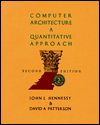Укажите регион, чтобы мы точнее рассчитали условия доставки
Начните вводить название города, страны, индекс, а мы подскажем
Например:
Москва,
Санкт-Петербург,
Новосибирск,
Екатеринбург,
Нижний Новгород,
Краснодар,
Челябинск,
Кемерово,
Тюмень,
Красноярск,
Казань,
Пермь,
Ростов-на-Дону,
Самара,
Омск
501
Previews
8
Favorites
Purchase options
Better World Books
DOWNLOAD OPTIONS
No suitable files to display here.
14 day loan required to access EPUB and PDF files.
IN COLLECTIONS
Texts to Borrow
Books for People with Print Disabilities
Internet Archive Books
Uploaded by
AltheaB
on
Computer Architecture: A Quantitative Approach, Fifth Edition, explores the ways that software and technology in the cloud are accessed by digital media, such as cell phones, computers, tablets, and other mobile devices. The book, which became a part of Intel’s 2012 recommended reading list for developers, covers the revolution of mobile computing. It also highlights the two most important factors in architecture today: parallelism and memory hierarchy.
This fully updated edition is comprised of six chapters that follow a consistent framework: explanation of the ideas in each chapter; a crosscutting issues section, which presents how the concepts covered in one chapter connect with those given in other chapters; a putting it all together section that links these concepts by discussing how they are applied in real machine; and detailed examples of misunderstandings and architectural traps commonly encountered by developers and architects. Formulas for energy, static and dynamic power, integrated circuit costs, reliability, and availability are included. The book also covers virtual machines, SRAM and DRAM technologies, and new material on Flash memory. Other topics include the exploitation of instruction-level parallelism in high-performance processors, superscalar execution, dynamic scheduling and multithreading, vector architectures, multicore processors, and warehouse-scale computers (WSCs). There are updated case studies and completely new exercises. Additional reference appendices are available online.
This book will be a valuable reference for computer architects, programmers, application developers, compiler and system software developers, computer system designers and application developers.
- Part of Intel’s 2012 Recommended Reading List for Developers
- Updated to cover the mobile computing revolution
- Emphasizes the two most important topics in architecture today: memory hierarchy and parallelism in all its forms.
- Develops common themes throughout each chapter: power, performance, cost, dependability, protection, programming models, and emerging trends («What’s Next»)
- Includes three review appendices in the printed text. Additional reference appendices are available online.
- Includes updated Case Studies and completely new exercises.
004.3
Х 383
Хеннесси Джон Л. Компьютерная архитектура. Количественный подход / Хеннесси Д.Л., Паттерсон Дэвид А. ; Таранчева М.В. (пер. с англ.) ; Ким А.К. (ред.). — Изд. 5-е. — М. : Техносфера, 2016. — 935 с. : ил., табл. — (Мир радиоэлектроники). — Пер. изд.: Computer architecture. A quantitative approach / Hennessy John I. — 5th ed. Amsterdam [etc.] : Elsevier, cop. 2012. Библиогр. : с. 839-868. Предм. указ. : с. 869-935. — ISBN 978-5-94836-413-1
Электронная версия книги
Метки: аппаратные средства, архитектура вычислительных машин, вычислительная техника, графический редактор, информационные системы, информационные технологии, компьютер, многопроцессорная обработка, мобильная связь, мобильные сети, ноутбук, обработка данных, планшет, программирование, программное обеспечение, программы командной строки, проектирование, радиоэлектроника, система проектирования, система управления базами данных, Хеннесси, центральный процессор
Uncategorized —
Ars reviews Computer Architecture: A Quantitative Approach
Computer Architecture: A Quantitative Approach
Authors: Hennesy & Patterson
Price: $71.35 at FatBrain; $83.95 at Amazon
Target Audience: EE students and those with a serious thirst for CPU knowledge. This is manna for CPU freaks, but overkill for anyone who doesn’t wanna bury their mind in it.
Rating: 5 out of 5 woo-hoos!

Computer Architecture: A Quantitative Approach, is the big stuff. Odds are that if you were to take a computer architecture class at almost any university, this would be the book you’d use. (The only exception to this would be if you took a class with a professor who has written a competing book on computer architecture. Then you’d use his book.) With the first edition published in 1990 and the second edition published in 1996, Computer Architecture is relatively up to date, and it’s what the chip designers of tomorrow are cutting their teeth on.
If anyone is qualified to talk about computer architecture, it’s David A. Patterson and John L. Hennessy. Patterson was at the vanguard of the RISC movement; he published a number of seminal RISC papers and even coined the term RISC. He was the man behind the design of Berkely’s RISC-I computer, the machine on which Sun’s SPARC was based. His other contributions include leadership of the team that invented RAID, as well as research into computation using networks of workstations (NOW). John Hennessy was also one of the leaders of the RISC movement in the early 80’s. He worked on the Stanford team that developed the MIPS architecture, and he later went on to found MIPS Computer Systems, which eventually merged with SGI. If you’re a member of the ACM and/or you have access to their Digital Library, I’d recommend doing a search for either of these authors and reading some of their other published work.
Fortunately for computer architecture students, Hennessy and Patterson are excellent writers. Often the lectures in senior-level CS and EE classes are awful; if you had a truly gifted lecturer for a computer architecture class then you were one of the fortunate few. But since you’re probably using Hennessy and Patterson (this is how Computer Architecture is referred to by computer architects), the quality of the lectures is of little importance. If you’ve got a good enough technical background, you can grasp most of the concepts in it just by reading the book thoroughly. Computer Architecture is by no means easy though, but its difficulty lies not in the presentation but in the subject matter. Because of the advanced nature of the subject matter, it’s not really a book for beginners. Nevertheless, if you’re willing to invest some serious effort and time into learning about modern microprocessor design, then even those with only basic programming and technical skills can get a lot out if it. (I got email once from a reader who’s a music major and who claims he read the book to great benefit.) If you don’t have a solid technical background then you shouldn’t expect to be able to grasp everything in the book, but you can still increase your knowledge immensely.
The book contains chapters on basic computer design, instruction set principles, pipelining, instruction-level parallelism, networks, multiprocessors, vector processing, and a whole host of other technologies that show up in mainstream CPUs. Each chapter goes in-depth on the topic and shows you the kinds of decisions and tradeoffs that go into the design and implementation of a particular technology. At the end of each chapter is a section called Fallacies and Pitfalls, which shows the reader what to look out for when designing and implementing the technology just discussed. The chapters also have a Historical Perspectives section that gives the history of the development of the technology under consideration. Finally, an appendix contains a survey of various RISC architectures: MIPS, SPARC, PowerPC, and PA-RISC; there’s also an entire appendix devoted to the 80×86.
A book like this doesn’t come cheap though. Engineering majors are used to paying $80 a piece for textbooks, but others might balk at the price. Still, if you want the best then you’ve got to pay for it. I refer to this book constantly while writing my articles; if you check the bibliography section of most of them you’ll most likely see Hennessy and Patterson listed somewhere. So if you’re serious about learning about computer architecture, and you’re willing to invest the time, effort, and money, then this book is essential reading.



